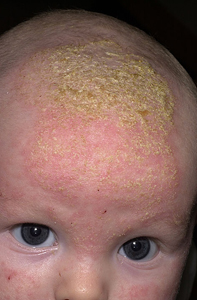The immune systems for Infants and children are still developing and this makes them more susceptible to skin problems.
Skin irritations can cause a lot of discomfort for infants and visible skin problems for children can cause embarrassing moments particularly at school.
Eczema
Eczema in children is a non-contagious skin condition which is quite common affecting around 10% of babies. It usually appears in early childhood and disappears around six years of age. The skin becomes dry, cracked and itchy, and may weep. It often starts at the elbows or knees. Eczema can vary in severity and alter on a daily basis. In some cases, eczema may continue into adulthood.
The immune system of children is immature and so many react inappropriately to a perceived irritant. This could be something on their skin, a food or a drink. Eczema is more common in children who have other allergies, such as asthma and hay fever.
Practitioners can help try and isolate what is causing the response, or parents can try and identify the irritant via trial and error. Children will often "grow" out of the problem as their immune system matures. However, that is of little comfort right now to the baby who has eczema, and the parents who are missing out on sleep.
Click on our "Herd about Us?" page to read some of the emails to MooGoo letting us know that a real change of formula has achieved. For these people, MooGoo eliminated whatever it was they were reacting to on their skin. However, different methods will work for different people.
What We Make for Children with Eczema
MooGoo’s Eczema and Psoriasis Cream (AUSTL196727) is for the symptomatic relief of Eczema. It is suitable for children and natural. (We list all our ingredients on our website so you can check that they are agreeable.)
Best first applied on damp skin immediately after washing and then whenever the skin becomes itchy or irritated. Use as directed, if symptoms persist consult your health care practitioner. Always patch test any natural product or food before use.
Probiotic Supplements Proven to Help Some Infant Eczema Sufferers
There have been a number of recent studies done which indicate that taking pro-biotic supplements in pregnancy or early childhood can help. This is a recent excerpt from "New Scientist Magazine, April 2008.
"Exposing pregnant mothers and infants to probiotic bacteria could help stimulate the growth of the immune system and potentially play a role in preventing allergies, say researchers.Probiotic bacteria are living micro-organisms that can be used to restore the ecosystem of the gut after a dose of antibiotics, or to help create a stable gut flora that is less prone to diseases like gastroenteritis... Probiotic children were also 30% less likely than their untreated counterparts to develop an itchy skin condition known as atopic eczema, which is often an early manifestation of allergies..."
There are good and poor quality probiotics on the market. Ask your health shop for advice. Zinc supplements are also often suggested by natural practitioners, and this will be of help if the natural diet is lacking in Zinc.

Cradle Cap
Cradle Cap
Another common infant skin problem is Cradle Cap.
This is red and dry flaky skin that will generally occur on the scalp, ears or face.
It is usually caused by a reaction to a type of yeast that is common in everybody’s skin called the Malassezia yeast.
What We Make For Cradle Cap
MooGoo Scalp Cream (AUST:196715) is for the symptomatic relief of Seborrheic Dermatitis (Cradle Cap). It is natural and suitable for children. We show all ingredients on our website to check they are suitable for you. It also make a wonderful natural moisturiser and some people do purchase this cream simply for that. The Eczema and Psoriasis Cream (196718) is also suitable for Cradle Cap. Use as directed and if symptoms persist consult your health care practitioner.
Nappy Rash
Most parents will be familiar with nappy rash.
It’s most commonly caused by a reaction to urea against the skin in wet nappies but it can also be triggered by a yeast problem.
Keeping the moisture away from the skin is the aim. So ensure nappies are changed whenever wet. Also a barrier cream that uses oil and Zinc to protect the skin from contact with urine.
What We Make for Nappy Rash.
Our Nappy Balm uses edible oils and Zinc to protect the skin from being in contact with urine. We list all of our ingredients on our website so you can check it is what you need. Best applied after each nappy change but at least twice per day, including on the nappy change before bed..Note: Sometimes a yeast infection can cause rapid reddening around the nappy area. If this occurs, a medicated antifungal cream can be used under the Nappy Balm.



